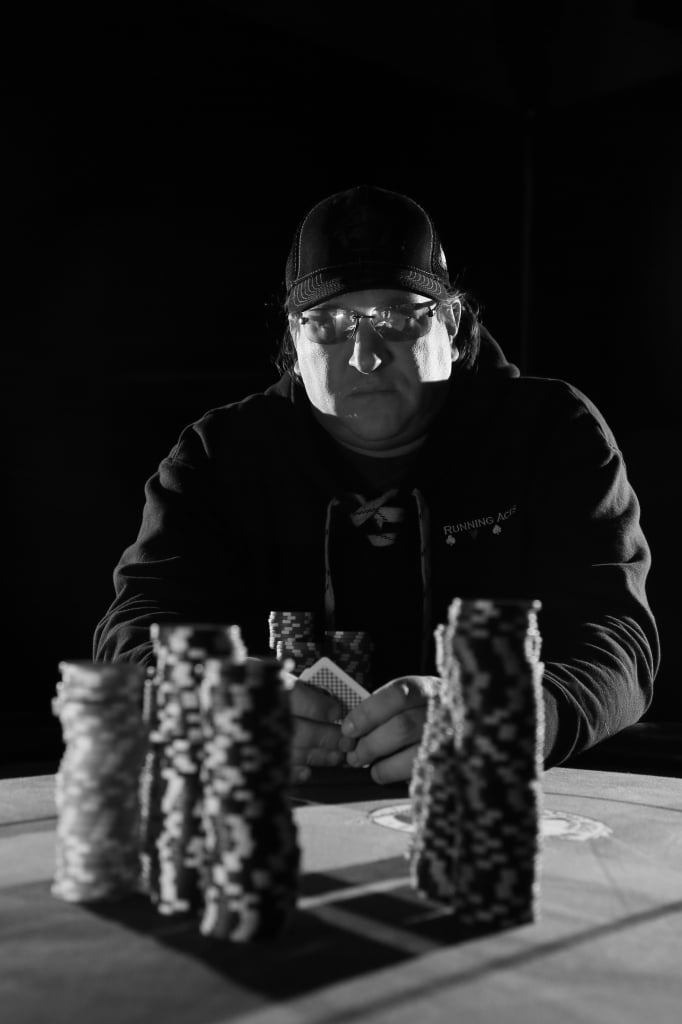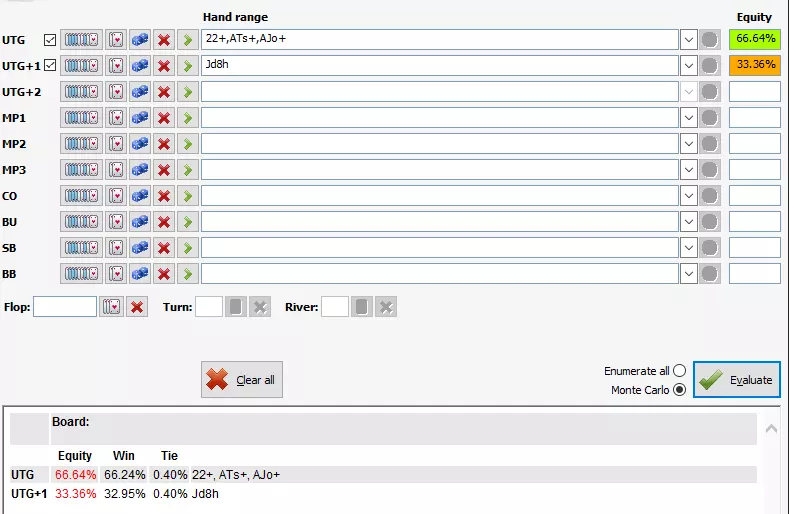Poker is a Game of Chips that Uses Cards & Live Poker Tournament Advice – with Chris “Fox” Wallace

Poker is a game of chips that uses cards. You may see it the other way around, but the best players all see it as chips > cards. Certainly both matter, but learning how to play your cards is easy, while learning to play your stack is tougher.
knowing how to play your stack size perfectly is highly profitable – so it should be a focus for anyone looking to get serious about the game of poker.
The key to learning to play your stack is thinking ahead.
e.g There are key questions you should think about BEFORE performing an action (bet/check/overbet/other):
- What will they do if I do X?
- How much of their range will they fold to this bet size vs. that bet size?
The two things, cards and chips, clearly work together here. Both are important. You have to put your opponent on a range of hands to guess how often they will fold, but you also have to plan it out and use your chips to make it happen.
Let’s look at an example where I had no hand at all and my cards didn’t mean anything. I also hate when poker authors just write about hands they played brilliantly, so there is a big mistake in this one on my part too.
“But Fox, shouldn’t you be posting a hand where you played well if you want people to buy your book ‘Short Stack Ninja’?”
Yes, actually. But I’m terrible at selling books and I hate paying my mortgage, so here we go.
The Setup – a $1,100 Buy-In Live event – Fold Equity & Table Image Considerations
The scene is important here. This was in my old home state of Minnesota and the tournament was a $1,100 buy-in event with a few hundred players.
I knew almost everyone at my table by name. I knew at least half the people in the tournament and had at least played with almost everyone. That’s just how it is with a smaller player pool and a bigger buy-in, you end up with the same players very frequently.
I was talking strategy with another player and joking around about how aggressive and dumb we are. We had each shown each other at least one bluff and were having fun with it. Most of the rest of the table were older or less experienced and I think they were listening hoping to learn something but I don’t think our conversation was particularly valuable to them.
So there is my first mistake. Talking strategy at the table. I almost never do that now, and can’t remember the last time I carried on a lengthy strategy discussion in a tournament that was big enough to matter.
There was one player, who was seated two to my left, who was listening intently. He was young, a sharp kid, and had some recent success. He was fairly aggressive and I knew that he was just dying to get involved in our little bluffing wars and have some fun with us.
I ran into a few rough hands as the day went on and was down to 27 big blinds just before dinner break. It was folded around to me on the button and I opened to 2.5 big blinds with J8o.
You should always have a hand or a plan, and since I didn’t have a hand, I had a plan.
The small blind folded, as he had been doing all day, but the big blind, my aggressive young friend, reraised me. He knew that I had been raising a lot of pots and that my button raise didn’t mean anything. And he was tired of me raising before he got a chance to do it himself.
So what did his reraise mean? I didn’t think it meant much, and in fact I expected it. And my stack size was a perfect size to shove all-in and make him fold a lot of his 3-betting range. My cards were okay, I may not have shoved on him with a really terrible hand, but they weren’t great. The key to the play was fold equity.
I knew that he knew that I was going to raise the button with a wide range. I also assumed that since his reraising range was very wide, that he would fold most of it if I went all-in. Many players in his position will just assume that they ran into a big hand and fold unless they have a big hand themselves.
So I shoved all-in instantly. It was part of the plan. If I waited, I might look like I needed to think about it and might be bluffing. But an insta-shove looked like I had a hand I was happy to play with. He folded immediately and showed me a medium strength hand. I think maybe it was A7o.
Then I made my big mistake. I showed my hand as well. I had been showing hands along with my strategy discussion partner, quite often. We had half the table on tilt because they couldn’t seem to catch us with a bad hand even though we were showing them off and bluffing each other.
It was pride, it was habit because I had been showing bluffs all day, and it was incredibly stupid. I was young, and it wasn’t something I would do today, but it was still really stupid, and not just for the reasons you are thinking.
My own table image was already wild and loose. I wasn’t hurting myself there. And the other person involved in the strategy talk already knew that I didn’t need a real hand to make the play. He probably saw it coming just like I did. No, it was a huge mistake because the player who had just folded was smart and aggressive and was very interested in learning the game and I was a respected player in the area.
I could see gears turning in his head when I showed my hand. He wasn’t mad, he was just thinking. I don’t know for sure, but I felt life I could see the math happening on a blackboard in his head. Here’s what I am afraid he was thinking.
“If he will raise really wide there, and he knows that I know that, then he knows that I will reraise him wide as well. And if he knows that, and he knows that he has a perfect stack to shove with, then he can plan the whole thing out and snap shove when I reraise.”
You see, if I raise to 2.5 big blinds, and he reraises any typical amount, let’s say 7.5 big blinds, then there will be enough money in the pot to make it worth stealing for me, and I will have just enough chips behind to make him fold.
After his reraise, plus the blinds and antes and my initial raise, the pot was 12.5 big blinds. And I was risking 24.5 big blinds to either win it without a showdown or see all five cards with my J8o and hope to get lucky.
I swear, I could see the gears turning in his head, realizing that he had just been outplayed and why and how. I felt like he would never be a target for that play again, and he was still going to be on my left for the rest of the day and at my tournament tables for years to come. The last thing I wanted to do was show him that I was capable of that play and also teach him how to make it himself and avoid it when I had a good spot for it. Ugh.
Using Math / Poker Tools to check if the Play is profitable
I’ve never actually run the math on this play, so let’s do it. I know it was profitable given my assumptions, but I’m curious if it would have been profitable with 72o. I’ll also show you why it wouldn’t be profitable against a very strong player.
I’m just guessing at his reraising range, it could be much wider or a little tighter, but your best guess is all you have when it comes to ranges, so let’s go with my estimate of a range like : 22+, A2s+, K7s+, Q8s+, J9s+, A2o+, K9o+, QTo+ (This represents about 29.5% of all possible starting hand combinations).
Now let’s assume that he will call my all-in with a range like : any pair (22+), ATs+, AJo+ – a little less than 10% of all hands. His calling range may have been a bit wider, but that’s my best guess.
Using those estimates, he will fold about 76% of the time. Now we just add up the equities. And don’t worry about doing all this math at the table, that isn’t how I teach this and it isn’t how I do it myself. I analyze hands this way to see whether I am doing something wrong in one direction or the other and alter my play, and what I teach my students, based on these calculations.
Most of my students have no interest in the analysis spreadsheet or equity calculator, which is why I clearly state in my book that you can skip the math sections if you like and just learn what the right plays are and when to use them because I’ve created the weapons and the armor using this math. I’ve done the work for you. I only include the math sections for readers who either doubt the basic principles and want to see proof, or who are nerds like I am and will enjoy reading about it.
Here is how the equities add up
Outcome 1: 66% of the time he will fold and I will win 12.5 big blinds. That is worth 8.25 big blinds in positive equity. This is known as fold equity. You may have heard of it, but thought it was a general concept. Nope. This is fold equity expressed as an actual number.
Outcome 2: 34% of the time he will call and when he does I will still have a chance to win. To find that number, I can just run my hand against his calling range in an equity calculator.
When he calls I still have over 33% equity against his tighter calling range. If I win, then I win the money in the pot plus a double up, so I increase my stack by 28.5 big blinds.
That calculation looks like .34 * .33 * 28.5 = 3.1977 or about 3.2 more big blinds in positive equity. It’s a big win when it happens, but it doesn’t happen very often because he has to call and I have to win and both of those things are only about 1 in 3 in this case.
When he calls and I lose I am out of the tournament and have lost the remaining 24.5 big blinds in my stack. He will call 34% of the time, and he has about 67% equity, so that calculation looks like .34 * .67 * 24.5 = 5.581 or about 5.6 big blinds in negative equity.
Now that we have the equities, we just add them up: 8.25 + 3.2 – 5.6 = 5.85
This means that every time I make this play, averaged out over time of course, I make almost six big blinds. That is more than 20% of my stack, a gamble that is much too good to turn down.
I just ran the numbers again while giving myself 72o, but I won’t bore you, or myself with more equations. I didn’t even do them myself, I just plugged the numbers into my hand analysis spreadsheet. But the results are as I expected, the play is still profitable to the tune of 4.2 big blinds, or a little more than 15% of my stack. Still a very profitable play and much too good to turn down.
The numbers didn’t drop all that much when I gave myself the worst hand in poker because my hand is rarely going to matter. The numbers only really plummet when I assign my opponent a stronger range so that he won’t fold as often. Which explains one of the reasons why showing him my hand was absolutely terrible.
If he only reraises with hands that are strong enough to call a shove, my play is horrible and I lose mountains of equity every time I make it. And I have just taught my opponent to do the one thing that will ruin this play. Ugh. Fox, you are terrible.
This play was more than ten years ago. The player I made it against would never fold now. No reasonable player in the modern era would. You still find players who make this mistake, but they are more rare every day and much more common at lower buy-ins.
That is why I talk about never three-betting and folding when you are below twenty five big blinds and almost never doing so when you are below thirty big blinds. Because if you do, you are offering your opponent a remarkable bargain.
In my new book, Short Stack Ninja, I have broken down the stack sizes into zones and covered situations like this to help you understand which plays work well in a particular zone in the weapons sections and how to avoid having those weapons used against you in the armor section. Then I cover why these plays work, and include a math section at the end of each chapter.
At the end of the book I use hand examples, five or six for each chapter, to show how the plays work and when they should be avoided. But what I don’t cover is how dumb it is to show your cards and teach your opponents how to make these plays or tip them off that you have that knowledge yourself. Don’t do that. Be smarter than I was. If you’re going to teach people about these plays, make sure you are getting at least $7.99 a copy for your book =)



